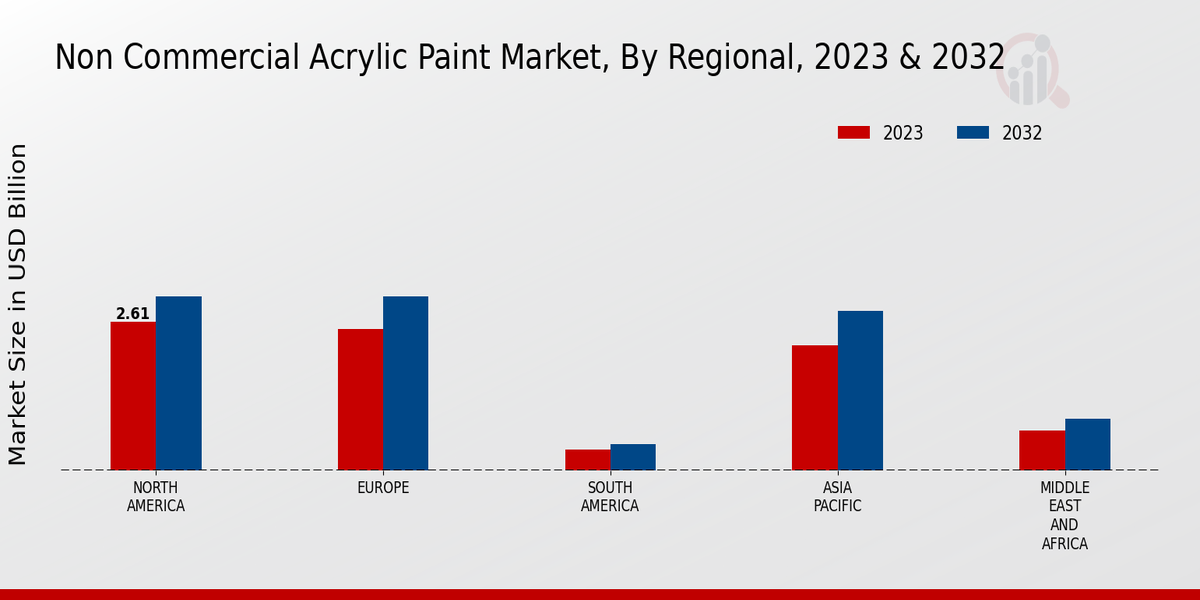Expansion of DIY Culture
The Global Non-Commercial Acrylic Paint Market Industry is significantly influenced by the expansion of the DIY culture. As individuals increasingly engage in home improvement and artistic projects, the demand for acrylic paints has surged. This trend is particularly evident among millennials and Gen Z consumers, who often seek creative outlets and personalized home decor solutions. Retailers have responded by enhancing their product offerings, providing a wider range of colors and finishes to cater to this burgeoning market. The DIY movement not only drives sales but also encourages experimentation with acrylic paints, thereby fostering brand loyalty and repeat purchases.
Increased Online Sales Channels
The Global Non-Commercial Acrylic Paint Market Industry is experiencing a transformation due to the increased availability of online sales channels. E-commerce platforms are becoming essential for consumers seeking a diverse range of acrylic paints. This shift allows manufacturers to reach a broader audience, including those in remote areas where traditional retail options may be limited. Online sales provide convenience and often competitive pricing, making it easier for consumers to access high-quality products. As the trend continues, it is likely to bolster market growth, further solidifying the position of acrylic paints in the global art supply landscape.
Growth in Art Education Programs
The Global Non-Commercial Acrylic Paint Market Industry is benefiting from the growth in art education programs across various levels. Schools and community organizations are increasingly incorporating art classes into their curricula, emphasizing the importance of creativity and self-expression. This trend has led to a higher demand for affordable and accessible art supplies, including acrylic paints. As educational institutions prioritize art education, the market is likely to see a steady increase in sales. This is particularly relevant as the market is projected to reach 11.3 USD Billion by 2035, indicating a sustained interest in artistic endeavors.
Rising Demand for Eco-Friendly Products
The Global Non-Commercial Acrylic Paint Market Industry is experiencing a notable shift towards eco-friendly products. As consumers become increasingly aware of environmental issues, there is a growing preference for paints that are low in volatile organic compounds (VOCs) and made from sustainable materials. This trend is reflected in the market dynamics, where manufacturers are adapting their product lines to meet these demands. For instance, several brands have introduced acrylic paints that comply with stringent environmental regulations, appealing to environmentally conscious consumers. This shift is likely to contribute to the market's growth, with projections indicating a market value of 8.74 USD Billion in 2024.
Technological Advancements in Paint Formulation
The Global Non-Commercial Acrylic Paint Market Industry is witnessing technological advancements in paint formulation, which enhance product performance and user experience. Innovations such as improved drying times, better adhesion, and enhanced color retention are becoming increasingly common. These advancements not only cater to the needs of artists and hobbyists but also align with the growing demand for high-quality products. Manufacturers are investing in research and development to create paints that meet these evolving standards. As a result, the market is likely to experience a compound annual growth rate of 2.38% from 2025 to 2035, reflecting the positive impact of these innovations.



















Leave a Comment